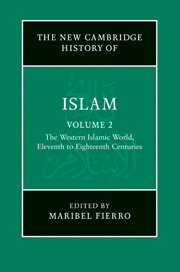Book contents
- Frontmatter
- Introduction
- PART I AL-ANDALUS AND NORTH AND WEST AFRICA (ELEVENTH TO FIFTEENTH CENTURIES)
- PART II EGYPT AND SYRIA (ELEVENTH CENTURY UNTIL THE OTTOMAN CONQUEST)
- 6 Bilād al-Shām, from the Fāṭimid conquest to the fall of the Ayyūbids (359–658/970–1260)
- 7 The Fāṭimid caliphate (358–567/969–1171) and the Ayyūbids in Egypt (567–648/1171–1250)
- 8 The Mamlūks in Egypt and Syria: the Turkish Mamlūk sultanate (648–784/1250–1382) and the Circassian Mamlūk sultanate (784–923/1382–1517)
- 9 Western Arabia and Yemen (fifth/eleventh century to the Ottoman conquest)
- PART III MUSLIM ANATOLIA AND THE OTTOMAN EMPIRE
- PART IV NORTH AND WEST AFRICA (SIXTEENTH TO EIGHTEENTH CENTURIES)
- PART V RULERS, SOLDIERS, PEASANTS, SCHOLARS AND TRADERS
- Glossary
- Bibliography
- Index
- References
9 - Western Arabia and Yemen (fifth/eleventh century to the Ottoman conquest)
from PART II - EGYPT AND SYRIA (ELEVENTH CENTURY UNTIL THE OTTOMAN CONQUEST)
Published online by Cambridge University Press: 28 March 2011
- Frontmatter
- Introduction
- PART I AL-ANDALUS AND NORTH AND WEST AFRICA (ELEVENTH TO FIFTEENTH CENTURIES)
- PART II EGYPT AND SYRIA (ELEVENTH CENTURY UNTIL THE OTTOMAN CONQUEST)
- 6 Bilād al-Shām, from the Fāṭimid conquest to the fall of the Ayyūbids (359–658/970–1260)
- 7 The Fāṭimid caliphate (358–567/969–1171) and the Ayyūbids in Egypt (567–648/1171–1250)
- 8 The Mamlūks in Egypt and Syria: the Turkish Mamlūk sultanate (648–784/1250–1382) and the Circassian Mamlūk sultanate (784–923/1382–1517)
- 9 Western Arabia and Yemen (fifth/eleventh century to the Ottoman conquest)
- PART III MUSLIM ANATOLIA AND THE OTTOMAN EMPIRE
- PART IV NORTH AND WEST AFRICA (SIXTEENTH TO EIGHTEENTH CENTURIES)
- PART V RULERS, SOLDIERS, PEASANTS, SCHOLARS AND TRADERS
- Glossary
- Bibliography
- Index
- References
Summary
Western Arabia
From the second half of the fourth/tenth century the ʿAbbāsid caliphate’s hegemonic monopoly in western Arabia eroded. The economic and geo-strategic importance of the Red Sea intensified in the wake of the ʿAbbāsid state’s decline, and the basic significance of the Ḥijāz as goal of the pilgrimage (ḥajj) and original abode of Islam widened. In the period under study the region became an object of imperial strategies in which ʿAbbāsids, Fāṭimids, Ayyūbids, Rasūlids, Mamlūks and others had their share. Within this framework of supra-regional power politics the foundation and consolidation of the Sharīfī emirates of Mecca and Medina, the main local political actors in western Arabia, took place.
In Mecca, descendants of the Prophet Muḥammad by his grandson al-Ḥasan took over power during the sixties of the tenth century CE. Thus began Sharīfī government there for nearly a millennium to come. The rise of the emirate coincided with the beginning of Fāṭimid rule in Egypt and it was to the Fāṭimids that the Sharīfs had to pay allegiance at first. Early Sharīfī ambitions for independence culminated in the proclamation as caliph by the ruling Sharīf in 401/1010. Yet, the Fāṭimids could dominate Mecca, and in 455/1063 their Yemeni vassals, the Ṣulayḥids, temporarily controlled the city to install a pro-Fāṭimid reign after the end of the first Ḥasanid clan in governance, the Mūsāwīs.
- Type
- Chapter
- Information
- The New Cambridge History of Islam , pp. 285 - 298Publisher: Cambridge University PressPrint publication year: 2010
References
- 1
- Cited by



